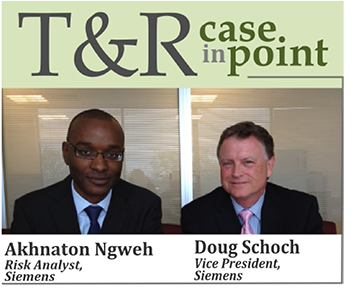 Siemens AG is a global powerhouse. It produces electronics and electrical engineering products for companies in the manufacturing, energy, and healthcare segments in more than 290 major production facilities worldwide, and it provides infrastructure solutions to cities and metropolitan areas.
Siemens AG is a global powerhouse. It produces electronics and electrical engineering products for companies in the manufacturing, energy, and healthcare segments in more than 290 major production facilities worldwide, and it provides infrastructure solutions to cities and metropolitan areas.
Siemens Capital Company LLC (SCC), a wholly owned subsidiary of Siemens AG, is the central treasury service provider for Siemens-affiliated companies in the Americas. It is one of four Siemens treasury centers globally.
Several years ago, Siemens launched a credit warehouse program designed to improve transparency into commercial customer credit data across the company. Treasury & Risk caught up with vice president Doug Schoch and risk analyst Akhnaton Ngweh to discuss the 'why,' the 'how,' and the outcome of the project.
T&R: The credit warehouse was a major undertaking; Siemens Capital Company even spun off a new subsidiary, Siemens Credit Warehouse, Inc., to manage the program in the U.S. What were the pain points that led your company to take such drastic measures to gain better insights into customer credit data?
Doug Schoch: Like many companies in today's world, Siemens was dealing with large amounts of commercial customer data, and synthesizing and leveraging this information was an ongoing challenge. We have a lot of business units across the globe, and it was difficult for any one group to gain a holistic perspective on the receivables portfolio of Siemens as a whole.
 Each credit team at the local level was managing customers' credit risk separately. That meant that although each team limited the exposure of its business unit to credit risk from any particular counterparty, we knew that the company overall had large exposures to some of our biggest customers. As the world economy began to falter, and some of our major customers started having financial difficulties, we needed to be able to see which companies posed extraordinary credit risk to Siemens globally. That just wasn't feasible when the data was stored in dozens of different databases around the world.
Each credit team at the local level was managing customers' credit risk separately. That meant that although each team limited the exposure of its business unit to credit risk from any particular counterparty, we knew that the company overall had large exposures to some of our biggest customers. As the world economy began to falter, and some of our major customers started having financial difficulties, we needed to be able to see which companies posed extraordinary credit risk to Siemens globally. That just wasn't feasible when the data was stored in dozens of different databases around the world.
T&R: What track did Siemens take to resolve this challenge?
DS: Well, the company decided in 2008 to address this dilemma. We started consolidating short-term receivables data from multiple business units into one central group in treasury. The goals were to increase credit risk awareness across Siemens, enable the centralized group to actively manage the company's credit risk on a global scale, and provide an additional source of liquidity for Siemens. That's how the global Siemens Credit Warehouse program was created.
T&R: So, how does the Siemens Credit Warehouse work?
DS: On a daily basis, Siemens business units transfer their trade receivables data to the program's global database, which is hosted in Germany. We developed the database software in-house, based on SAP technology. Local units' SAP ERP systems connect to the credit warehouse database, and their data is delivered to the program via a file transfer. The data is aggregated and enhanced with internal credit risk ratings and credit reports. The Siemens Credit Warehouse then makes consolidated information on Siemens' commercial customers available internally through a web-based application.
So the program synthesizes commercial receivables data, then shares a holistic view of Siemens' commercial customers through the one global platform. Over 1,500 Siemens employees are now leveraging consolidated information from over 270 Siemens business units around the world. They're able to access up-to-date information about receivables exposures, risk profiles, and credit data on Siemens customers.
T&R: How does this create value for Siemens?
Akhnaton Ngweh: Now Siemens business units are able to make more-informed decisions, work more efficiently, reduce credit information expenses, and collaborate on common challenges.
T&R: OK, how does the Siemens Credit Warehouse help the company make better-informed business decisions?
AN: Various groups within Siemens are using the aggregated information about receivables exposures to better understand the company's relationships with commercial customers and suppliers. Local units can identify the major business partners of Siemens as a whole, and they can communicate with other Siemens entities to understand payment experience and terms for customers they share with other units. So one business unit can avoid extending additional credit to a customer that has a past-due account with another unit.
The Siemens Credit Warehouse team provides internal credit risk ratings to indicate the creditworthiness of Siemens' commercial customers. These risk ratings are based on information obtained from financial reports, external rating agencies, external credit data, and Siemens' customer default experiences. The risk ratings support local credit teams in their day-to-day responsibilities. A customer's rating profile provides a comprehensive, high-level perspective on the customer's overall risk, and the standardized methodologies of the risk ratings help ensure consistent handling and comparisons across Siemens.
By combining this new outlook with their own expertise, local teams can make more-informed decisions. Siemens units are using the risk ratings in areas such as up-front credit approval, collections, and general reserve setting.
T&R: What other benefits does the credit warehouse offer?
AN: Local business units are able to save money on the cost of credit information. Because the credit warehouse makes credit reports and internal risk ratings available on one platform for new and existing commercial customers, units evaluating a commercial customer for the first time can re-use credit information already compiled for other Siemens entities. By using a central platform, we're reducing duplication and optimizing the company's spend on credit information.
The local teams are constantly being challenged to achieve more with tight resources. The risk ratings can help in this regard because they provide a quick, reliable, and cost-effective measure of credit risk. Local business units are able to improve efficiency by incorporating the internally generated credit risk ratings into their existing credit processes. The Siemens Credit Warehouse supports the smooth integration of these risk ratings at the unit level by offering an automated solution that can transfer risk rating information into each business unit's ERP system. An increasing number of Siemens business units are now implementing the automated solution in order to build the risk ratings into their standard processes.
In addition to the Siemens Credit Warehouse credit database, business units connected to the credit warehouse can access a daily rating-change report, which contains up-to-date risk ratings on their customers. This report can be imported automatically into the business unit's SAP ERP system with a specific function. Some IT programming is required on the business unit's side to enable the automated data import.
T&R: You mentioned collaboration, as well. How does the program enable collaboration across Siemens?
AN: Collaboration among local credit teams on the ground, and between those teams and the Siemens Credit Warehouse team, creates new opportunities to raise risk awareness across Siemens. Participating units have begun sharing ideas and discussing their common challenges, and the credit warehouse is enabling those conversations. The Siemens Credit Warehouse group has also organized numerous collaborative education sessions, which have highlighted best practices within Siemens. Local teams are learning from one another, and the exchange of information is promoting process improvement.
There's one other big component of the program that we haven't talked about. The Siemens Credit Warehouse also provides political- and credit-risk protection by purchasing eligible receivables from Siemens business units. Participating business units receive cash, either upon payment by the customer or, in case of customer default, from the Siemens Credit Warehouse. Eligible receivables that are overdue for more than 90 days are treated as defaults. The business unit selling a receivable to the Siemens Credit Warehouse is responsible for servicing activities such as collections and receivables management.
T&R: What challenges did your team—or does your team still—face in convincing business units to use the Siemens Credit Warehouse services?
DS: Our local units have been successful using their own methods to assess credit risk, and they're very knowledgeable about the ins and outs of their own processes. So some of the credit teams at the local level may be reluctant to embrace new concepts such as our internally developed credit risk ratings. The logic behind the risk ratings is still relatively new to the business units.
T&R: What are you doing to encourage adoption of the risk ratings?
DS: Ongoing education is key. The Siemens Credit Warehouse team is learning from the local units, and vice versa. The SCW risk advisory team has been visiting various business units and hosting peer discussions. These sessions are very valuable to the SCW team, as they provide us with feedback and help us align our advisory services and tools with the needs of the business units.
T&R: Where will the Siemens Credit Warehouse program go from here?
DS: The program has come a long way, and its journey of providing value continues. Ongoing communication with the local business units will be essential for the credit warehouse service to remain relevant. This collaboration will pay dividends down the road as the program continues to tailor its services and systems. The future looks promising, as the SCW group and local units continue to work together to unlock the potential of one of Siemens' unique and most important business assets: our receivables data.
For further information on the Siemens Credit Warehouse program, feel free to contact Doug Schoch at [email protected] and Michael Pschiuk at [email protected].
© 2025 ALM Global, LLC, All Rights Reserved. Request academic re-use from www.copyright.com. All other uses, submit a request to [email protected]. For more information visit Asset & Logo Licensing.




